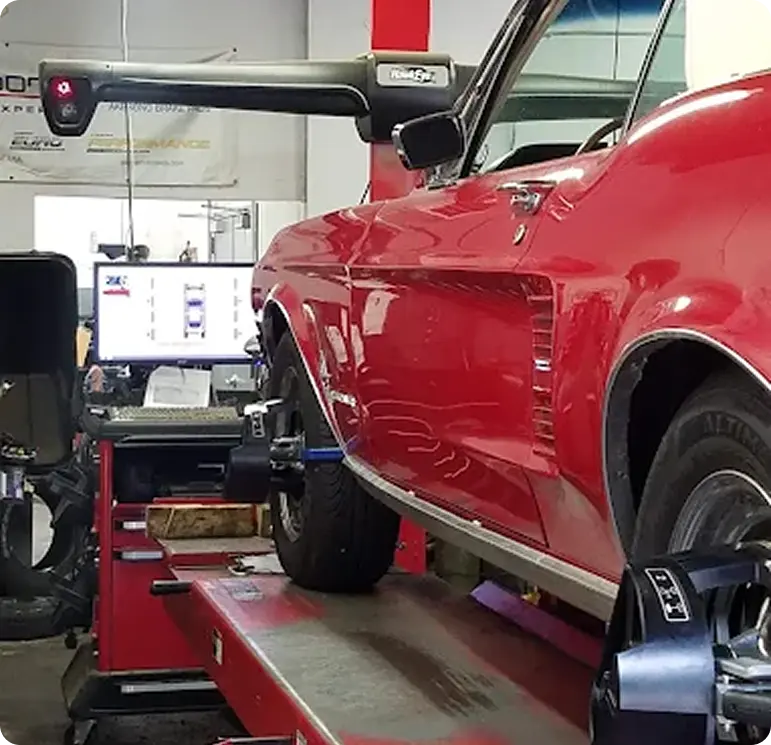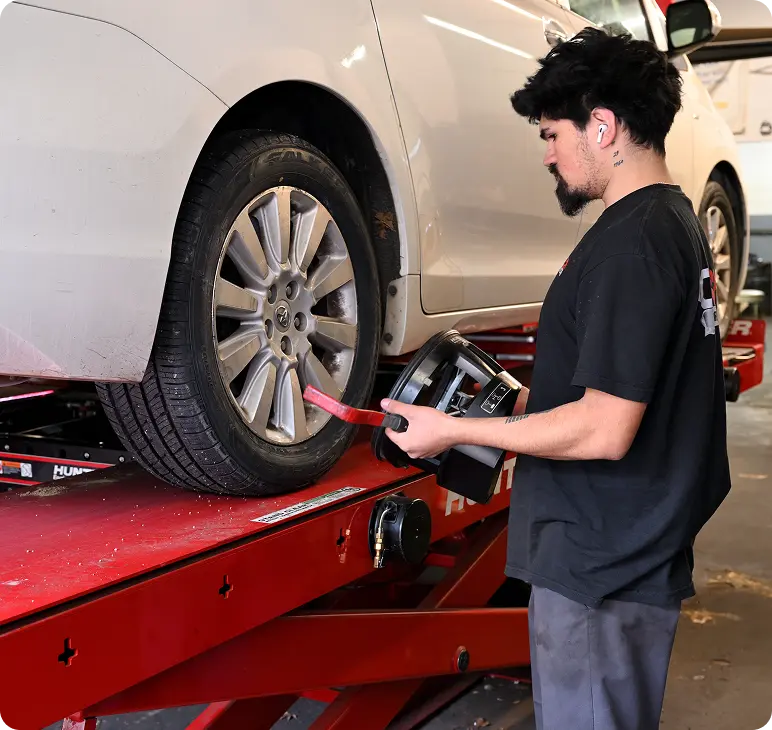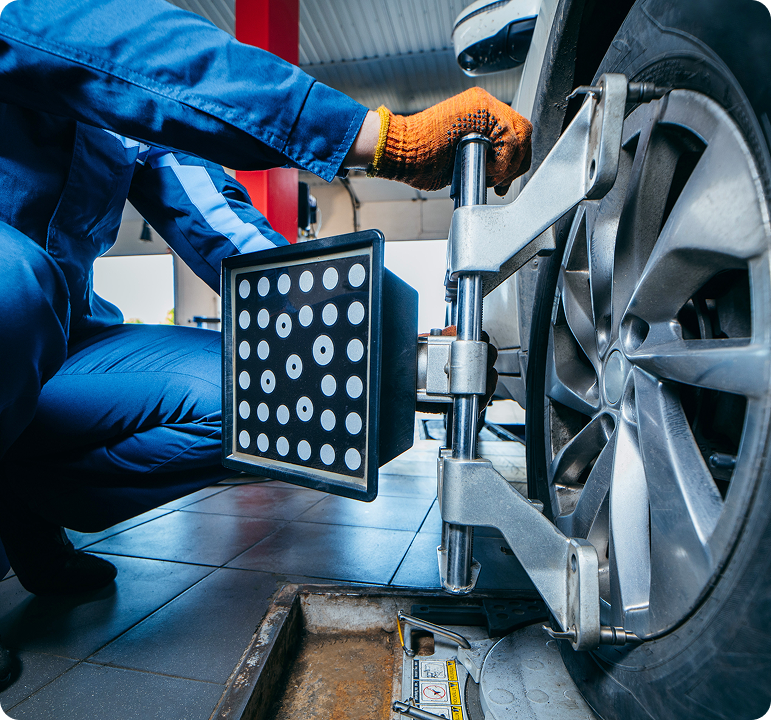
1818 St. Albans Dr #106, Raleigh,
NC 27609

Need Help
919-872-1999
1818 St. Albans Dr #106, Raleigh,
NC 27609

Need Help
919-872-1999
Alignment is a crucial aspect of vehicle maintenance that significantly impacts the performance, safety, and longevity of your car. Proper alignment ensures that your vehicle's wheels are positioned correctly relative to each other and the road. This process involves adjusting the angles of the wheels to the manufacturer's specifications, which helps in achieving optimal handling, tire wear, and fuel efficiency.
Vehicle alignment refers to the adjustment of the vehicle's suspension, which is the system that connects a vehicle to its wheels. It's not an adjustment of the tires or wheels themselves. Proper alignment involves adjusting the angles of the tires, which affects how they make contact with the road. The key alignment angles are camber, caster, and toe.

Proper alignment is essential for vehicle safety. Misalignment can cause the vehicle to pull to one side, making it difficult to control, especially at high speeds or in emergency situations. Ensuring your wheels are correctly aligned enhances your ability to steer the vehicle accurately and safely.
A well-aligned vehicle can significantly improve fuel efficiency. When the wheels are aligned correctly, there is less rolling resistance, meaning the engine doesn't have to work as hard to move the vehicle forward. This results in better fuel economy and lower fuel costs.
One of the most immediate benefits of proper alignment is the extended life of your tires. Misalignment causes uneven tire wear, which can lead to premature tire replacement. By maintaining correct alignment, you ensure that your tires wear evenly, saving you money in the long run.

Uneven tire wear indicates poor wheel alignment. If your tire tread wears unevenly, it's a clear sign your vehicle urgently needs an alignment.

If your vehicle pulls to one side while driving straight, it could be a sign of misalignment. This issue can be dangerous as it affects your ability to steer the vehicle accurately.

When driving on a straight, level road, your steering wheel should be centered and straight. If it is off-center, even when driving straight, it’s a sign that your vehicle needs an alignment.

Vibration or shaking in the steering wheel can indicate alignment issues. This is often caused by the wheels pulling in opposite directions due to misalignment.
The alignment process begins with a thorough inspection of the vehicle's suspension and steering components. This includes checking for any worn or damaged parts that could affect alignment.
Using advanced alignment machines, technicians measure the current alignment angles of the vehicle. These machines provide precise measurements of camber, caster, and toe angles.
Based on the measurements, technicians adjust the alignment angles to the manufacturer’s specifications. This may involve adjusting the tie rods, control arms, and other suspension components to achieve the correct angles.
After adjustments are made, a final alignment check is performed to ensure all angles are within the recommended specifications. The technician will also test drive the vehicle to confirm that it handles correctly.

The cost of a vehicle alignment can vary based on several factors, including the type of vehicle, the alignment service required (two-wheel or four-wheel alignment), and the local labor rates. Additionally, any necessary repairs to suspension or steering components will add to the overall cost.
On average, a standard two-wheel alignment can cost between $50 and $75, while a four-wheel alignment typically ranges from $100 to $150. It’s important to consider this as an investment in your vehicle’s performance and safety.
Regular alignments can save you money in the long run by preventing premature tire wear and improving fuel efficiency. Most experts recommend having your vehicle's alignment checked at least once a year or every 12,000 miles, whichever comes first.
The cost of a vehicle alignment can vary based on several factors, including the type of vehicle, the alignment service required (two-wheel or four-wheel alignment), and the local labor rates. Additionally, any necessary repairs to suspension or steering components will add to the overall cost.
On average, a standard two-wheel alignment can cost between $50 and $75, while a four-wheel alignment typically ranges from $100 to $150. It’s important to consider this as an investment in your vehicle’s performance and safety.
Regular alignments can save you money in the long run by preventing premature tire wear and improving fuel efficiency. Most experts recommend having your vehicle's alignment checked at least once a year or every 12,000 miles, whichever comes first.
Professional alignment services use state-of-the-art equipment and experienced technicians to ensure precise alignment adjustments. This level of expertise and technology is crucial for achieving optimal alignment and performance.
During an alignment service, technicians also inspect other critical components of your vehicle's suspension and steering systems. This comprehensive approach ensures that any potential issues are identified and addressed promptly.
A properly aligned vehicle provides a smoother and more comfortable driving experience. You’ll notice improved handling, reduced tire wear, and better fuel efficiency, all contributing to a more enjoyable and cost-effective drive.
.accordion-body, though the transition does limit overflow..accordion-body, though the transition does limit overflow..accordion-body, though the transition does limit overflow..accordion-body, though the transition does limit overflow..accordion-body, though the transition does limit overflow.Ensuring proper alignment is essential for the safety, performance, and longevity of your vehicle. By understanding the importance of alignment and recognizing the signs of misalignment, you can take proactive steps to maintain your vehicle's optimal condition. Investing in professional alignment services not only enhances your driving experience but also saves you money in the long run by extending tire life and improving fuel efficiency. At Creech Import, we are dedicated to providing expert alignment services to keep your vehicle running smoothly and safely.
For an estimate with the most trusted auto repair shop in Wake County, Creech Import Repair!



At Creech Import Repair, our philosophy is simple: Treat customers with kindness, respect, and honesty, and success will follow. Contact us for any and all of your automotive repair needs.